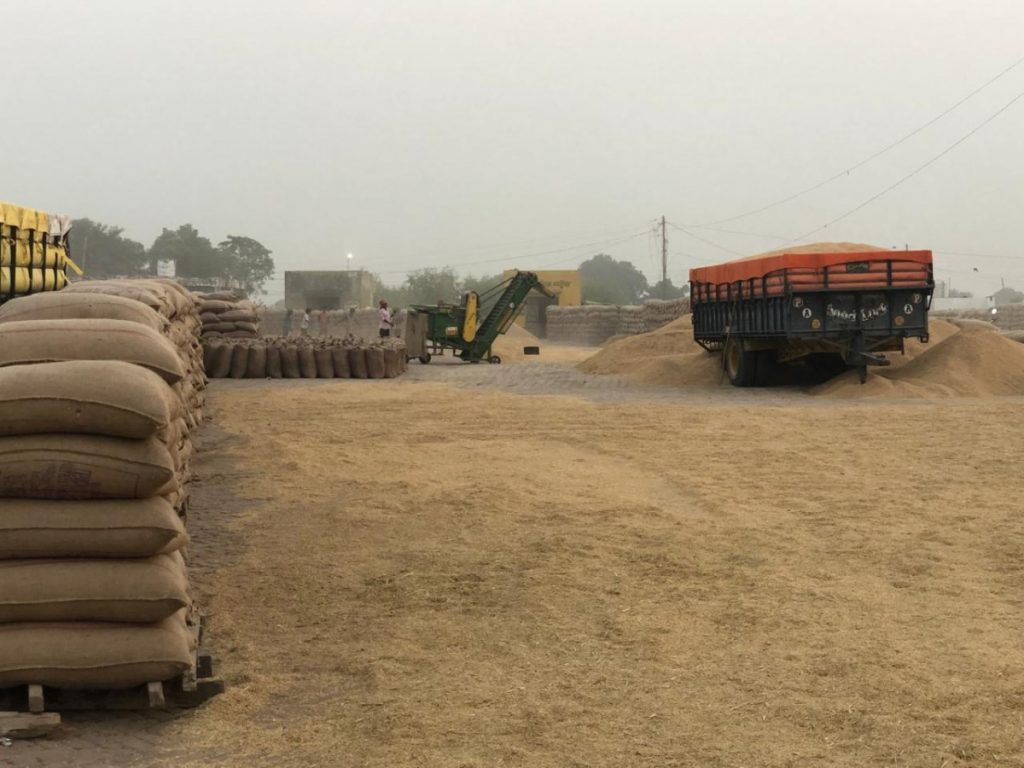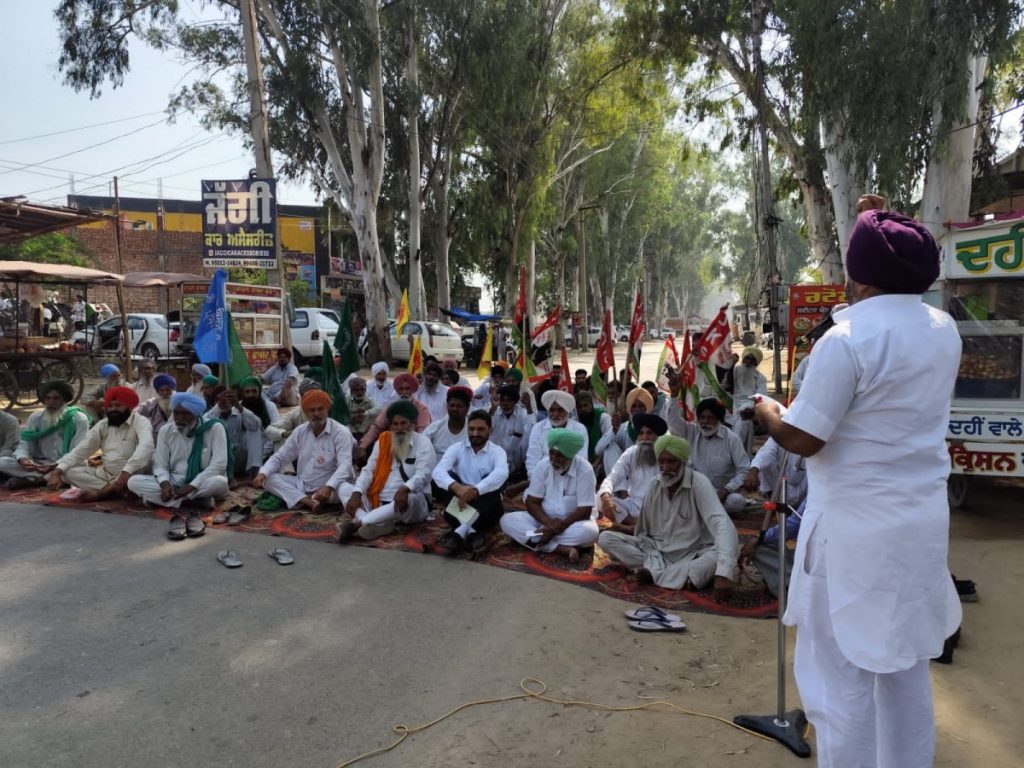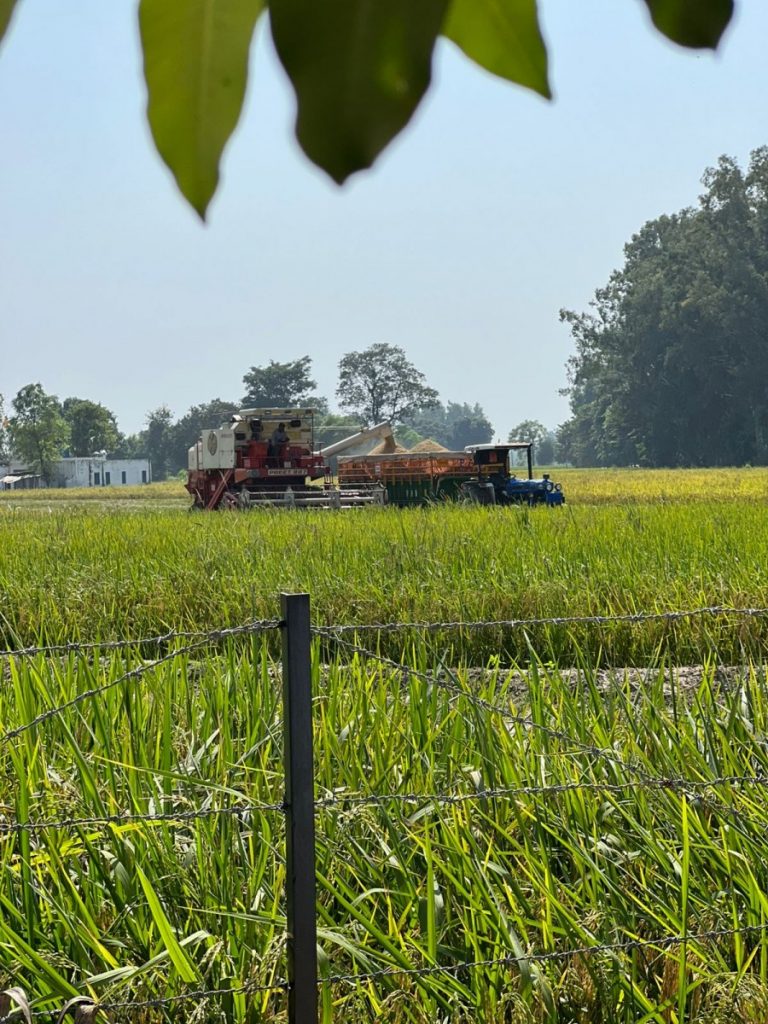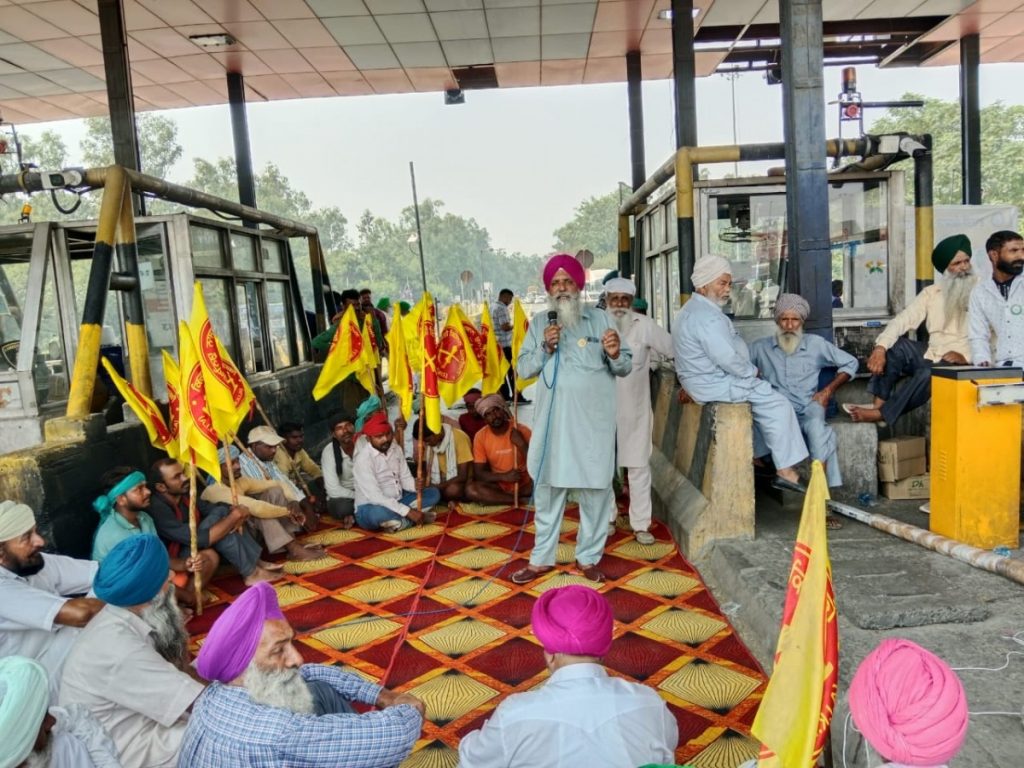As Paddy Glut Pushes Punjab Towards Major Agrarian Crisis, Questions Over Mann and Modi Govts' Delayed Response
Jalandhar: A major agrarian crisis following a paddy glut and poor lifting of the crop has left farmers, commission agents, rice millers and labourers frustrated with the Aam Aadmi Party government in Punjab and the Union government under Narendra Modi.
A paddy glut is when excess paddy is produced.
The lifting of paddy began on October 1, but even after a fortnight, only 3.73 lakh metric tonnes of paddy have been procured by state agencies of a total of 4.57 lakh metric tonnes that reached mandis, as per records of the Punjab Mandi Board. Mandis are grain markets where paddy is procured. Out of the 3.73 lakh metric tonnes too, so far, only 20,000 tonnes of paddy have been lifted from the mandis.
Punjab is expecting a total of about 185 lakh metric tonnes of paddy this season. After this paddy is processed in the mills, it is expected to come to 125 lakh metric tonnes. However, a major chunk of last year’s roughly 130 lakh metric tonnes of paddy is yet to be lifted from warehouses and rice mills in Punjab.
On October 14, Punjab chief minister Bhagwant Mann met Union Minister for Consumer Affairs and Food and Public Distribution Pralhad Joshi. Assurances of paddy procurement in this year’s kharif marketing season followed. However, farmers, arhtiyas (middlemen) and millers have gone on strike over the tardy lifting of paddy. Grain markets have been closed.
However, arhtiyas (middlemen) and millers have ceased work, and many grain markets have been closed.
Farmers have alleged that this was another attempt by the Modi government to push its pro-corporate model in agriculture, and to destroy the bond between farmers, arhtiyas and labourers as well as the robust Agricultural Produce Marketing Committee (APMC) system in Punjab. All villages in Punjab are connected with APMC mandis.
The Mann government – itself facing farmers' blame – has in turn blamed the Modi government too.
The opposition Congress and Shiromani Akali Dal parties have accused the AAP and the BJP for deliberately targeting Punjab as its farmers were at the forefront of the 2020-2021 farmers’ protest. Nearly all stakeholders are of the view that behind this crisis lies the pro-corporate policies of the BJP government, which they have been pushing in Punjab’s agrarian economy for the last four years.

Paddy lying in the open at a grain market on Jalandhar-Hoshiarpur road. Tractors loaded with paddy are also lined up at the grain markets across Punjab due to poor lifting of the crop. Photo: Kusum Arora.
Millers in a fix
The foremost issue is the lack of storage space in Food Corporation of India (FCI) godowns, where rice is kept after it is processed by Punjab’s rice millers. Every year, the Punjab government stocks paddy at rice mills following procurement. There it is milled and later, picked up by the FCI.
Rice millers in Punjab are already facing losses as last year's milled rice is still in their godowns. Around 5,500 rice millers in Punjab are unwilling to take on more paddy for milling as a result.
Tarsem Lal Saini, president of the Punjab Rice Millers Association and of the All India Rice Millers Association, shared how godowns were choked with last year’s paddy that is yet to be procured by FCI.
“Had the AAP government taken up the matter of a paddy glut with the Union government on time, the situation would not have gone out of hand,” he said.
Saini also said that the Union government is yet to release around Rs 7,000 crore as part of the Rural Development Fund (RDF), which is generated from the state government charging a 3% cess on the procurement of food grains for the central pool.
“The entire system has been left to crumble. The RDF is used for the development of rural infrastructure like roads, buildings and the maintenance of grain markets. Both the Punjab and the Union governments are to be blamed for this crisis,” he added.
Around 36,000 kilometres of roads in Punjab’s villages lay broken, the Mann government has claimed in its petition to the Supreme Court in 2023 over the Union government's release of RDF.
'Farmers biggest losers'
Farmers said that the issue of lifting last year’s paddy crop should have been resolved by March 31 – or at the latest by May 31 – this year.
“Farmers are the biggest losers in this case. This is the first time in our lives that we are witnessing such poor lifting of our yield. The AAP government is squarely responsible for this mess. We have harvested around 70% of our paddy, but no procurement is taking place. Our trolleys are lying parked at our homes. We do not know when procurement will begin and when we will get paid,” said Jalandhar-based progressive farmer Jaskaran Johal.
The Samyukta Kisan Morcha (SKM), which led the 2020-2021 farmers’ protest at the Haryana-Delhi border, is supporting the current agitation and has held meetings with various stakeholders. SKM leader and Kirti Kisan Union press secretary Raminder Singh Patiala termed this crisis as a corporate attack on the farming sector.
“The agriculture sector is constantly under attack from pro-corporate policies. The corporate sector has been keeping an eye on the grain trade and farmers’ land. Therefore, the current structure of APMC and the agricultural industry associated with this structure is their target,” he alleged.
As part of the protests, the SKM, along with farmers, arhtiyas, rice millers and labourers also held a chakka jam (roadblock) and a rail roko (a stopping of trains) on October 13, from 12 to 3 pm, across Punjab.

Farmers during chakka jam against poor lifting of paddy on October 13, 2024 at Lehragagga in Punjab CM Bhagwant Mann’s home turf Sangrur district, Punjab. Photo: By arrangement.
Protesters have announced a gherao of Mann’s and AAP MLAs’ residences on October 18 if their demands are not met.
Among their demands are the early lifting of paddy, 2.5% of MSP as commission for arhtiyas per quintal of paddy, increase in the payment to grain market labourers for lifting sacks of paddy from Rs 1.80 per quintal to Rs. 3.03, and compensation for the loss of Rs 300 per quintal for a particular variety of rice.
A commission, a small hike
In addition to their commission demand, arhtiyas are also against the FCI for not handing them their outstanding dues in the labourers’ Employees Provident Fund.
Speaking to The Wire, Ravinder Singh Cheema, president of the Arhtiya Association Punjab, called the current crisis an ‘undeclared strike’ in grain markets.
“We fear that the paddy glut will escalate in the coming days. Arhtiyas are suffering because of the Union government’s decision to provide a fixed price of Rs 46 per quintal in commission, as compared to the previous policy of offering a 2.5% per quintal commission under the APMC Act. With a 2.5% commission, we used to get a commission of around Rs 55 per quintal,” Cheema said.
“If the Union government does not accede to our demands, we will completely boycott the procurement process,” he threatened, adding to allege that the Union government has a different yardstick for Punjab.
On the other hand, the labourers employed at grain markets are also demanding a hike in their daily wage of Rs 1.80 per quintal for loading paddy onto trucks. They pointed out that the daily wage for this work has been Rs 3.03 in Haryana for many years and demanded that their daily wage be increased by Rs 2 per quintal.

Tractors loaded with paddy are either lying parked in the grain markets or in the houses of farmers due to poor lifting of the crop. Photo: Kusum Arora.
Mann says all is well
Mann has repeatedly come under attack from the farming community and the opposition for allegedly failing to act on time in handling this crisis.
However, after meeting Union minister Joshi, Mann claimed that the latter agreed to arrange for 120 lakh metric tonnes of paddy to be lifted and taken outside the state by March 2025. Mann also urged Joshi to ensure the procurement of at least 20 lakh metric tonnes of foodgrains per month from the state till March 31, 2025.
In a statement, Mann highlighted the problems faced by millers and farmers. He also noted that the commission being paid to arhtiyas had not been increased in the last five years.
He said that while the MSP of crops is increased every year, arhtiyas are being paid between Rs 45.38 and 46 per quintal in commission since 2019-20, even though the APMC Act provides for a commission of 2.5% on MSP per quintal, which means a benefit of Rs 58 per quintal.
On the demand of commission for arhtiyas, Joshi told Mann that the Union government would consider this issue in its next meeting.
“Mann was just given 15 minutes to raise our issues with the Union minister. This shows the lack of seriousness of the Union government in addressing our woes,” said Cheema.

A combine machine during paddy harvesting at Salempur Masandan village in Jalandhar. Photo: Kusum Arora
Bajwa slams Mann’s policies
Leader of opposition in Punjab, Partap Singh Bajwa, addressed a press conference in Delhi and lashed out at Mann for allegedly pushing the state’s farming and economy into a mess.
Bajwa pointed out that while paddy procurement began on October 1, Mann went to Delhi to raise the paddy glut issue with Joshi only on October 14.
“Last year too, Punjab had faced this problem,” he said.
The senior Congress leader said that since all godowns were full to the brim, Mann should have met Modi and Joshi to sort out the matter at least six months ago. “Had the Punjab chief minister ensured the movement of at least 10-15 lakh metric tonnes of paddy per month, the problem of paddy glut would not have arisen,” he added.
Further pointing out that the stock of paddy will increase in grain markets in the coming days, Bajwa said this would pose further problems. “Rice needs to be stored in godowns because it gets discoloured, broken and loses moisture leading to losses. But the paddy yield was lying in the grain markets,” he said.

Farmers at a toll plaza on Jalandhar-Amritsar national highway during a chakka jam on October 13, 2024. Photo: By arrangement.
A controversial rice variety
Bajwa also targeted Mann for aggressively promoting the ‘PR 126’ variety of rice as it grows faster and would save water and electricity.
“Earlier, farmers used to sow other hybrid varieties, which used to grow in 110 to 120 days. Mann ensured that farmers sow PR 126, saying that it grows in 92 to 95 days, saving one month’s water and electricity. But when no scientific study was done, how could he claim this?” he asked.
On the issue of rice millers facing losses, Bajwa said that earlier, they used to get 67 kg of milled rice from one quintal of paddy, but that they now got only 60 to 62 kg of rice per quintal of PR 126 rice.
“The rice shellers are facing a loss of around five kg of rice per quintal, which means a loss of Rs 300 per quintal and a total loss of Rs 6,000 crore. Who will compensate for the loss of rice millers – Mann or the Modi government?” he asked.
Bajwa also lashed out at Mann for his statement that Joshi assured full procurement of rice by March 31, 2025. He said, “Even if the entire Indian railways and its carriages are pressed into service, milled rice cannot be picked by this date. It is simply impossible.”
Of arhtiyas’ protests demanding 2.5% commission per quintal, Bajwa said: “This seems to be a conspiracy of the Modi government to derail Punjab’s economy. The BJP has a huge grudge against Punjab’s farmers for their role in farmers’ protest. Their agenda is to ultimately sell paddy at depressed rates to private players like Adani, who already has three silos at Moga, Kathunangal in Amritsar and Raikot in Ludhiana,” he said.
This article went live on October eighteenth, two thousand twenty four, at twenty-eight minutes past two in the afternoon.The Wire is now on WhatsApp. Follow our channel for sharp analysis and opinions on the latest developments.




